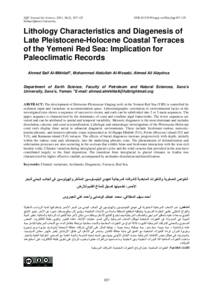Document
Lithology characteristics and diagenesis of late pleistocene-holocene coastal terraces of the Yemeni Red Sea : implication for paleoclimatic records.
Identifier
DOI:10.53539/squjs.vol26iss2pp107-125
Source
Sultan Qaboos University Journal for Scientific. v. 26, no. 2, p. 107-125.
Contributors
Al-Wosabi, Mohammed Abdullah., Author
Alaydrus, Ahmed Ali., Author
Other titles
الخواص الصخرية والتغيرات المابعدية للشرفات المرجانية لعهدي البليستوسين المتأخر والهولوسين في الجانب اليمني للبحر الأحمر: تضمينها كسجل للمناخ القديم للأرض.
Country
Oman.
City
Muscat.
Publisher
College of Science, Sultan Qaboos University.
Gregorian
2021-12-26
Language
English
English abstract
The development of Holocene-Pleistocene fringing reefs in the Yemeni Red Sea (YRS) is controlled by sediment input and variations in accommodation space. Lithostratigraphic correlation of environmental facies in the investigated sites shows a sequence of successive events, and each can be subdivided into 2 or 3 main sequences. The upper sequence is characterized by the dominance of coral and coralline algal frameworks. The lower sequences are varied and can be attributed to spatial and temporal variability. Meteoric diagenesis is the most dominant and includes dissolution, calcrete, and coral recrystallization. Lithologic and mineralogic investigations of the Pleistocene-Holocene coral reefs display three aerial to subaerial diagenetic environments. These include freshwater-vadose, meteoric-marine-phreatic, and meteoric-phreatic zones represented at Al-Hajaja-Dhubab (Tr1), Perim (Mayyun) island (Tr2 and Tr3), and Kamaran island (Tr4) terraces. The effects of burial diagenesis increase progressively with depth, initially within the vadose zone and, ultimately, into the underlying phreatic zone. The phenomenon of dolomitization and siderisation processes are also occurring in the sections that exhibit brine and freshwater interaction with the iron-rich basaltic rocks. Climatic variation during interglacial-glacial cycles and the wind systems that prevailed in the area have contributed largely to the final deposition. The transition from interglacial to glacial climates in Arabia was characterized by higher effective rainfall, accompanied by aeolianite dissolution and karstification.
ISSN
2414-536X
Arabic abstract
يتم التحكم في تطور الشعاب المرجانية في عصر الهولوسين والبليستوسين في البحر الأحمر اليمني (YRS) من خلال مدخلات الرواسب والاختلافات في مساحة الإقامة. يُظهر الارتباط الطبقي الحجري للسحنات البيئية في المواقع التي تم فحصها سلسلة من الأحداث المتعاقبة، ويمكن تقسيم كل منها إلى تسلسلين أو ثلاثة تسلسلات رئيسية. يتميز التسلسل العلوي بهيمنة الهياكل المرجانية والطحالب المرجانية. تتنوع التسلسلات السفلية ويمكن أن تعزى إلى التباين المكاني والزماني. يعتبر التشكل النيزكي هو الأكثر شيوعًا ويتضمن الذوبان والكالسيت وإعادة تبلور المرجان. تُظهر الدراسات الحجرية والمعدنية للشعاب المرجانية في عصر البليستوسين-الهولوسين ثلاث بيئات ديوجينية جوية وتحت جوية. وتشمل هذه المناطق المياه العذبة والفادوس، والمناطق النيزكية البحرية والرياحية والمتمثلة في مصاطب الحجاجة - ذوباب (Tr1)، وجزيرة بريم (ميون) (Tr2 وTr3)، ومدرجات جزيرة كمران (Tr4). تزداد تأثيرات تهجين الدفن تدريجيًا مع العمق، في البداية داخل منطقة الفادوز، وفي النهاية، إلى المنطقة فرياتيك الأساسية. كما تحدث ظاهرة الدلمتة وعمليات التكسير في الأجزاء التي تظهر تفاعل المياه المالحة والمياه العذبة مع الصخور البازلتية الغنية بالحديد. وقد ساهم التباين المناخي خلال الدورات الجليدية-الجليدية وأنظمة الرياح التي سادت في المنطقة إلى حد كبير في الترسيب النهائي. اتسم الانتقال من المناخ الجليدي إلى المناخ الجليدي في شبه الجزيرة العربية بارتفاع معدل هطول الأمطار، مصحوبًا بذوبان الإيواليانيت والتشكل الكارستي.
Category
Journal articles

